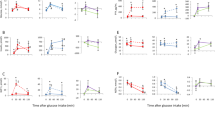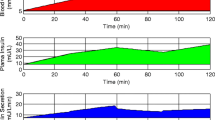Abstract
Background
Bariatric surgery improves glucose metabolism.
Methods
To assess the direct role of surgery (i.e., independently of significant weight loss) on insulin sensitivity (homeostasis model assessment (HOMA) insulin resistance (IR) and oral glucose insulin sensitivity (OGIS)), on glucose and insulin response (area under the curve (AUC) blood glucose (BG) and AUC insulin (Ins)) to oral glucose tolerance test (OGTT), and on glucose tolerance, 11 subjects underwent OGTT (75 g, p.o.) before and 5 days after laparoscopic gastric banding (LGB; no change of initial body mass index (BMI), 46.7 ± 2.21 kg/m2), and ten subjects underwent OGTT before and 7 days after biliopancreatic diversion (BPD; BMI decreased from 54.5 ± 3.75 to 52.1 ± 4.03 kg/m2). As controls, we considered OGTT performed twice over a 30–45-day period in two groups of subjects [BMI 43.0 ± 0.41 (n = 13, matched with LGB subjects for BMI) and 48.2 ± 0.49 kg/m2 (n = 14, matched with BPD subjects for BMI), respectively] with stable weight (±1.5 kg); a further control group was made of 11 subjects with a spontaneous weight loss similar to BPD subjects (BMI from 55.5 ± 1.27 to 52.2 ± 1.35 kg/m2).
Results
Fasting BG and OGIS improved in BPD subjects and in subjects with spontaneous weight loss, not in LGB subjects or in weight-stable controls; HOMA-IR, AUC BG, and AUC Ins only decreased in BPD subjects. Glucose tolerance was not affected in a different way in the various groups of subjects.
Conclusions
These data indicate an early effect of BPD different from LGB on insulin sensitivity and on glucose and on insulin response to OGTT, mostly independent of weight loss.


Similar content being viewed by others
References
Buchwald H, Estok R, Fahrbach K, et al. Weight and type 2 diabetes after bariatric surgery: systematic review and meta-analysis. Am J Med. 2009;122:248–56.
Scavini M, Pontiroli AE, Folli F. Asymptomatic hyperinsulinemic hypoglycemia after gastric banding. N Engl J Med. 2005;353:2822–3.
Guidone C, Manco M, Valera-Mora E, et al. Mechanisms of recovery from type 2 diabetes after malabsorptive bariatric surgery. Diabetes. 2006;55:2025–31.
le Roux CW, Aylwin SJ, Batterham RL, et al. Gut hormone profiles following bariatric surgery favor an anorectic state, facilitate weight loss, and improve metabolic parameters. Ann Surg. 2006;243:108–14.
Shak JR, Roper J, Perez-Perez GI, et al. The effect of laparoscopic gastric banding surgery on plasma levels of appetite-control, insulinotropic, and digestive hormones. Obes Surg. 2008;18:1089–96.
Pontiroli AE, Pizzocri P, Librenti MC, et al. Laparoscopic adjustable gastric banding for the treatment of morbid (grade 3) obesity and its metabolic complications: a three-year study. J Clin Endocrinol Metab. 2002;87:3555–61.
Matthews DR, Hosker JP, Rudenski AS, et al. Homeostasis model assessment: insulin resistance and b-cell function from fasting plasma glucose and insulin concentrations in man. Diabetologia. 1985;28:412–9.
Mari A, Pacini G, Murphy E. A model-based method for assessing insulin sensitivity from the oral glucose tolerance test. Diabetes Care. 2001;24:539–48.
American Diabetes Association. Diagnosis and classification of diabetes mellitus. Diabetes Care. 2006;29:S43–8.
Kelley DE, Wing R, Buonocore C, et al. Relative effects of calorie restriction and weight loss in noninsulin-dependent diabetes mellitus. J Clin Endocrinol Metab. 1993;77:1287–93.
Adami GF, Cordera R, Camerini G, et al. Recovery of insulin sensitivity in obese patients at short term after biliopancreatic diversion. J Surg Res. 2003;113:217–21.
Gonlachanvit S, Hsu CW, Boden GH, et al. Effect of altering gastric emptying on postprandial plasma glucose concentrations following a physiologic meal in type-II diabetic patients. Dig Dis Sci. 2003;48:488–97.
de Jong JR, van Ramshorst B, Gooszen HG, et al. Weight loss after laparoscopic adjustable gastric banding is not caused by altered gastric emptying. Obes Surg. 2009;19:287–92.
Melissas J, Daskalakis M, Koukouraki S, et al. Sleeve gastrectomy-a “food limiting” operation. Obes Surg. 2008;18:1251–6.
Bernstine H, Tzioni-Yehoshua R, Groshar D, et al. Gastric emptying is not affected by sleeve gastrectomy; scintigraphic evaluation of gastric emptying after sleeve gastrectomy without removal of the gastric antrum. Obes Surg. 2009;19:293–8.
Garcia-Fuentes E, Garrido-Sanchez L, Garcia-Almeida JM, et al. Different effect of laparoscopic Roux-en-Y gastric bypass and open biliopancreatic diversion of Scopinaro on serum PYY and ghrelin levels. Obes Surg. 2008;18:1424–9.
Prachand VN, Alverdy JC. The role of malabsorption in bariatric surgery. World J Surg. 2009;33:1989–94.
Zhang H, DiBaise JK, Zuccolo A, et al. Human gut microbiota in obesity and after gastric bypass. Proc Natl Acad Sci USA. 2009;106:2365–70.
Pontiroli AE, Baio G, Stella L, et al. Effects of naloxone on prolactin, luteinizing hormone, and cortisol responses to surgical stress in humans. J Clin Endocrinol Metab. 1982;55:378–80.
Pontiroli AE, Stella L, Crescenti A, et al. Surgical stress in humans and pituitary-adrenal secretion. In: Delitala G, editor. Opioid modulation of endocrine function. New York, NY: Raven Press; 1984. p. 147–53.
Perego L, Pizzocri P, Corradi D, et al. Circulating leptin correlates with left ventricular mas in morbid (Grade III) obesity before and after weight loss induced by bariatric surgery: a potential role for leptin in mediating human left ventricular hypertrophy. J clin Endocrinol Metab. 2005;90:4087–93.
Disclosure
The authors have no conflict of interests with the contents of this manuscript.
Author information
Authors and Affiliations
Corresponding author
Rights and permissions
About this article
Cite this article
Pontiroli, A.E., Gniuli, D. & Mingrone, G. Early Effects of Gastric Banding (LGB) and of Biliopancreatic Diversion (BPD) on Insulin Sensitivity and on Glucose and Insulin Response after OGTT. OBES SURG 20, 474–479 (2010). https://doi.org/10.1007/s11695-010-0076-4
Received:
Accepted:
Published:
Issue Date:
DOI: https://doi.org/10.1007/s11695-010-0076-4




